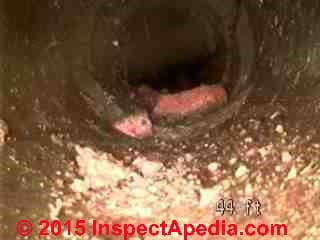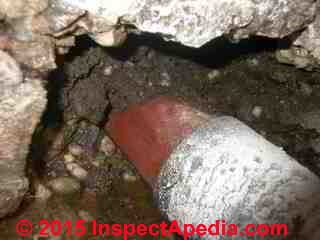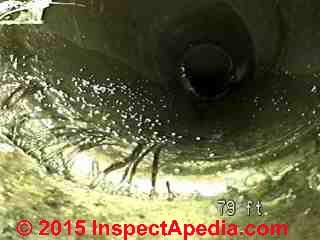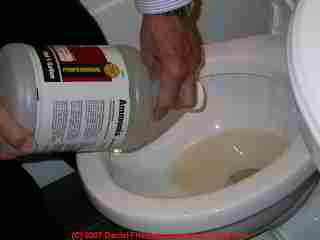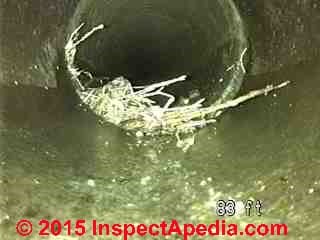 Root Killers or Chemicals to Clear Drain Clogs?
Root Killers or Chemicals to Clear Drain Clogs?
- POST a QUESTION or COMMENT about the use of root killer treatments to control trees, shrubs, or other plants whose roots invade the septic system piping or leachfield (soakaway bed)
Are root killers an effective remedy for root-clogged sewer lines, drain lines, piping, drainfields?
Advice on dealing with root invasion of sewer piping, drain piping, septic tanks, and septic drainfields. This article describes approaches to removing and preventing root invasion and root clogging in sewer piping, septic piping, and septic drainfield pipes.
At page top is a photo of roots growing into a clay sewer line connecting a Seattle WA building to the public sewer. Simply removing the roots or using a "root killer" won't fix a problem with recurrent clogging in a deteriorated or damaged sewer pipe.
This is part of our article series on sewer and septic installation, repair, maintenance and on planting trees, shrubs, or grasses or other plants on or near septic systems.
InspectAPedia tolerates no conflicts of interest. We have no relationship with advertisers, products, or services discussed at this website.
- Daniel Friedman, Publisher/Editor/Author - See WHO ARE WE?
Using Root Killers or Chemicals In Drain Piping, Sewer Pipes, Septic Drainfields
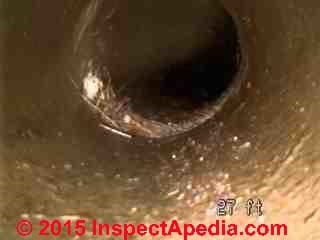 Planting the wrong things or in the wrong places can lead to
the need for expensive septic system repairs.
Planting the wrong things or in the wrong places can lead to
the need for expensive septic system repairs.
Planting trees, shrubs, and even some ground covers over septic system components are causes of septic system failure in the drain field, leach field, seepage bed, or similar components. When roots invade a sewer line (shown below) or septic tank, seepage pit, cesspool, drywall or sewer and septic piping, including soakbeds or drainfields, the clogging problem can be expensive.
Simply removing the roots by any means: mechanical using a drain auger or power snake, or more slowly by trying to kill the roots with chemicals, might temporarily improve wastewater or sewage flow but the problem is not fixed.
[Click to enlarge any image]
The photo at above left illustrates a modest root invasion at the joint in a clay sewer line at a property in Seattle, Washington.
While roots continue to grow and occasionally slow or clog this pipe between a building and a city sewer, the underlying problem is an old, deteriorating clay sewer pipe whose joints are subject to heaving and breakage (photo above-right).
Ultimately this line will need replacement. No amount of root killer, drain cleaner, or septic helper will repair a broken pipe.
See SEWER / SEPTIC PIPE CAMERAS for details.
Even where the sewer line or piping is not broken, just root-invaded through open joints, the most effective repair for root-clogging in drain or septic systems is by removing the root-invading plants themselves.
Tree, shrub or even some deep-rooting grasses and other plants will send out roots that find and are attracted by the nutrients in wastewater.
Those roots find their way into the sewer or drain piping system through cracks in older pipes, particularly clay sewer piping or older cracking ORANGEBURG PIPE .
At clay sewer lines we often find roots invading the piping system at the hub joints that are not tightly sealed or at even older octagonal clay pipe sewer lines that had no water-tight connectors in the first place. Sewage effluent seeps out into the soil around these pipe openings that in turn invite roots to enter, grow, and even increase the damage to the pipes.
Such root invasion is often undiscovered until building occupants begin to notice slow drains or worse, a sewage backup into the structure.
To repair root-invaded sewer piping, there are these approaches:
- Use a power auger to rip out roots from the pipes: you can expect the roots to re-grow and re-clog the piping system in 1-2 years, faster in some environments.
- Excavate and repair or replace broken, cracked or heaved sewer or septic piping to seal off any leaks of wastewater into the surrounding soils. This repair is suitable for un-perforated sewer piping such as between a building and the sewer main or building and a septic tank. Replacing root-invaded pipes is not going to be a lasting repair if we are replacing perforated drainfield or soakbed piping in septic fields where invading-root plants are nearby.
The photo above at left shows a too-common loose-fit and leaky connection between a cast iron house sewer main and a clay sewer pipe.
See PLANTS & TREES OVER SEPTIC SYSTEMS for a series of articles describing what plants are ok and which plants are not safe to install over or near septic components such as soakbeds, leachfields, or cesspools.
In the sewer line camera photo above at right you can see roots growing into the sewer piping at an open clay pipe joint. Removing a larger root and debris clog at this location can get the sewer working again but as you can see in the photo it is impossible to mechanically remove roots except from the pipe interior: the root stubs will grow back quickly.
See PLANTS & TREES OVER SEPTIC SYSTEMS - Remove aggressive-root plants that send deep roots into the sewer piping and that are planted too close to the septic fields or piping. The same article cited above will tell you the safe planting distances for common trees, shrubs, grasses and other ground covers.
- Try to kill aggressive-root plants by sending chemicals into the drain system. Products such as RootX®, Root Killer®, Robic Root Killer®, Foaming Root Killer®, and Hi-Yield Root Killer® are widely sold and have been tried by building owners for decades.
In my first home in New York (back in 1969) we tried every imaginable septic system treatment, additive, and killer. What finally worked? We replaced the collapsing rusted-out steel septic tank, broken-up clay hub-type sewer piping, and we replaced poorly-constructed, failed drainfield built in saturated soils.
It was not cheap, which is why like many consumers we were sorely tempted by the magic bullet approach of just pouring a magical product down the toilet. But there are some important limitations to the effectiveness, speed, and safety of this approach, as we discuss just below.
Using Root Killers to "Un-Clog" Septic Pipes or to "Prevent Septic System Clogging"
We advise against using chemicals or caustics to "kill" tree or other plant roots which may be present in or near septic system components. People fearing that roots will clog or have already clogged their septic system piping, particularly drainfield piping, are tempted to buy these products. This is another example of a "magic bullet" that does not work, is dangerous, contaminates the environment, and is illegal in some jurisdictions.
Root killers as environmental pollutants: OPINION: First, using a chemical to kill or to "prevent" invasion of roots in septic piping means you are pouring toxic chemicals and contaminants into the ground water - into the environment, and possibly right into your own or someone else's well and drinking water. This is a bad idea and is prohibited in many communities.
Root killers as a magic bullet to repair a septic system: OPINION: Second, if septic drainfield or other pipes are already clogged or partly clogged with tree or other plant roots, even if you killed the roots in the pipe you're leaving the clogging material.
If piping in a septic system has become root-clogged, it is often the case that not only are the pipes clogged, they may be dislocated or even broken by the growing tree roots. You may find you've contaminated the environment, left the clog in place, and wasted your money since you'll still end up digging up the clogged line to replace it. [The photograph above is a simulation of pouring a chemical into the septic system through a toilet. Don't do this.]
Planting trees, shrubs, and even some ground covers over septic system components are causes of septic system failure in the drain field, leach field, seepage bed, or similar components. Planting fruit trees, or vegetables (or anything else edible) over the septic drainfield might produce food that is unsafe to eat:
See SEWAGE CONTAMINANTS in FRUIT / VEGETABLES for details.
...
Reader Comments, Questions & Answers About The Article Above
Below you will find questions and answers previously posted on this page at its page bottom reader comment box.
Reader Q&A - also see RECOMMENDED ARTICLES & FAQs
Question: What liquid root killer can I use to kill the brush over my septic drainfield?
I have two septic tanks, the first seperates solids from liquid then sends the liquid to the second tank which has a septic pump that pumps the liquid UP to a drain field.
I want to kill brush over the drain field . The drain field is 1100 ft ABOVE my well . Is there a LIQUID root killer that I can use in this septic system as the copper pellets will never get up to the drain field and will sit in my seperator tank .
Can the copper pellets be ground into a powder - the powder mixed into a slurry that will be pumped to my drain field ? - donbranch0924@msn.com
Reply: we do not recommend brush or root killers over the drainfield - remove the plants instead
Don
We don't recommend chemicals and treatments in septic systems - search InspectAPedia for
"Septic System Additives & Treatments" for details.
Basically most such treatments are limited in effectiveness, risk damaging the environment, and are illegal in many areas.
If your drainfield piping is being invaded by roots we have found that even if you temporarily kill off roots in the piping they return in a year or two and repeat a costly clog. The solution is to either remove plants or excavate and install root passage barriers around the drainfield.
Take a look at PLANTS & TREES OVER SEPTIC SYSTEMS for details about planting over or near septic system components, and
see ROOT KILLERS in SEWER LINES or SEPTIC PIPES for our advice on the use of root killers in septic system tanks and drainfields.
Also see SEPTIC TREATMENTS & CHEMICALS for our explanation of the risks of using chemicals and other treatments in septic systems.
Question: Septic or sewer line treatment for redwood tree roots
What safe treatment is there for redwood tree roots...can I treat the end of root(s) I've exposed with something safe for aerobic bacteria in leach field? Can I 'paint' the end of the large root with something effective to kill only that root? Thanks. - Nanette
Reply:
Nanette, my OPINION is that if you have large trees close to a septic drainfield their roots will continue to invade the field. If you kill off an individual tree root by cutting it back, the tree will send out new roots in its place. If you kill off enough roots to keep the tree out of the drainfield you'll likely kill the whole tree - a hazard of a different sort.
Those tree roots are pretty smart - good at seeking out water and the nutrients in septic effluent.
Reader follow-up:
Thanks for your opinion. My redwood trees are 50 ft. away, but one of those roots has somehow navigated upward, I have it 'confined' in a 3" abs pipe, so I could 'treat it individually, if I knew what to do/what product to buy. The leach field is protected both upward and downward by cement-block retaining walls. It has lasted for 30 yr. until this year's 'root clog'.
I have dug up the leach field, cleaned the rocks, replaced the drain pipe system which is a gravity system, but now with 'vertical inspection ports', as well as a 'cleanout'/drop for root treatment separate from cement septic tank. I just need to know how to treat this one invasive root. SIGH. What can I pour into the pipe containing the root to kill just this one invasive root, safe for the San Lorenzo River 60 ft. away?
Reply:
Nanette: impressive that those trees sent out a 50 foot root. Look there are "root killer" products sold to dump into septic systems to try to kill off tree roots. They have the down side of leaving dead roots in the system, no permanent solution to the problem, and in at least some cases, contaminating the environment. With the river less than 100 feet from your septic system I'd prefer not to use chemicals.
If you've got just one bad boy tree root that wandered 50 feet from the tree and into your septic, I'd try to follow the root back 20 feet or more from the septic system and cut it off there.
Reader follow-up:
I agree that I don't want to use chemicals, either, i.e., copper sulfate, etc.
However, trying to 'follow that redwood root back' is not trivial in my situation, as the root has grown 'upward' about 8-10 ft. above the ground level of the tree, and removing that depth of material is not as, ha,ha, as smart as the tree is.
I was hoping for something like say, rock salt solution, confined to that root...is there no 'solution-solution', forgive me, for both the tree health (one root will not kill a redwood tree (coppice category), I am pretty sure it is not the 'tap root') and life-cycle leach field maintenance cost?
Thanks for your time in this discussion. Surely their is an environmentally harmonious way to solve this.
I am currently looking for information on 'root deterrents', which seem to be a better avenue of research than 'root killers.' So far, it seems that salt may be the 'solution'. Let me know if you have any further suggestions re environmentally conscious root deterrents than only the 'physical digging down 10 ft.' unusable suggestion in my case.
Reply:
In short, dumping salt or chemicals into the soil is not a recommended practice, and as I warned earlier, it's illegal in some jurisdictions. The risk is that you contaminate a well, groundwater, or other surface and subsurface waters, not to mention that root killers and root deterrent chemicals are a short-lived band-aid for a problem of roots invading septic systems.
The solutions that work are to clear out pipes, cut back roots, or where practical, remove trees or plants that are invading septics - not so practical in your case where you have large distant trees.
Even more costly are "solutions" that move the septic fields or attempt to insert buried barriers.
Last, research by septic experts such as Minnis and Gayman confirm that putting any significant levels extra salt directly into the drainfield or sending it there via a septic tank or building piping is a quick way to destroy the drainfield. I'd be concerned about putting enough salt in or around a drainfield to kill or retard root growth since it is risking if not plain asking for very expensive drainfield damage as well.
Reader follow-up:
I do not disagree nor not care for the advice given, but am looking for a long-term solution to my problem.
As my drainfield lasted 30 yr., instead of the usual 10 yr, until 'large root impacted', and, as I have cut that root back 7 ft. and 'confined it' in a 3" diameter abs pipe, one cannot say that I have solved the problem by ignoring your advice....I AM sensitive to my forest and my river, which is how we got involved in our discussion in the first place.
What we seem to agree on is that only physical 'confinement'/'redirection' of the root is the best ecological solution. Hmmm...
what I HAVE done, is improve my leach field by removing/cleaning the rocks, replacing the leach line pipe including new 'vertical inspection ports', and cleanout, such that, perhaps, 'mechanical' removal of any invasive roots can be handled by annual inspection and 'mechanical removal'by 'snake' cutting before impaction.
I appreciate the input from you that mechanical options are preferred to chemical options.
Reply:
Some mechanical approaches to avoiding use of chemicals to attack invading tree roots are in the next Q&A.
Question: tree roots are invading our septic tank; we cut down the tree but roots continue to be a problem
I had an elm tree near the tank and when the tank was pumped we saw the roots had penetrated the tank. We cut down the tree but it keeps coming back, which I assume means the roots are still alive and may continue to grow into the tank. Any suggestions on keeping the roots from finishing off the tank? I didn't plant the tree; it was there when I bought the place. Thanks, Cole
Reply: some mechanical approaches to keeping problem tree roots out of drain pipes & septic systems
Cole, persistent tree roots around septic components are indeed an annoying problem. Quite a few readers ask about using root killers. Our OPINION is that there is a risk of contaminating the environiment, such products (and all septic treatments) are actually illegal in many jurisdictions, and worse, years ago when we tried the most popular products we found that the root killer was not a long lasting repair - two years after de-clogging by removing roots from an invaded pipe and using root killer we had to clear the pipe again.
Other than manually digging out all of the invading root systems (and the stump) near your septic tank, you can reduce root invasion by making the septic system less attractive to and harder to invade by tree and other plant roots:
- be sure that there are no groundwater leaks into the septic tank
- be sure that there are no effluent leaks out of the septic tank (caused by a system that is backing up, failing, or damaged tank, piping, or D box).
- replace problem piping that has been root-invaded using new PVC pipes with glued or gasketed watertight joints. A sewer or septic line that leaks effluent into the surrounding soils both attracts roots from nearby plants and it offers an opening through which roots enter the piping system.
Question: what to do about neighbor's tree invading my septic system
(Apr 13, 2014) Anonymous said:
My neighbor has several large elm trees that are already invading my septic system and tank. They are just the other side of the fence and only a few feet from my tank and drainfield. I have no legal recourse to make him remove the trees. I've been pouring copper sulfate down the toilet and into the tank and this works for awhile but of course they just grow back. I am a single Mom with very tight finances and I don't have the money to replace the tank or to pay the many thousands to remove the huge trees.
The roots may even be growing into the foundation of my home and up into my sump pump. I was wondering if I could pour the copper sulfate right along the fence line to stop the roots from coming into my property. I am really desperate here and I don't know what else to do.
I have called the city, an attorney, the health dept., etc. The trees may have grown wild so I don't have any legal options. I have to talked to the neighbor and they said they would take them down but I think they found out that it would cost thousands to take them all down as they are very tall and very close to my home, their garage and power lines. I don't know what else to do to stop these roots from coming into my property. Old ordinances allowed the fence line very close to my home and tank system.
Reply:
Anon, you already know my view of using root killers in septic fields from the article above. Your note seems to confirm that the chemical doesn't solve the septic problem you describe and I add that you're at risk of killing the bacteria needed for the septic tank and drainfield to function properly. The result of that is a ruined drainfield and contamination of the environment around and in your property with sewage pathogens - none of which sound very appealing.
Even cutting down the trees won't remove the roots nor cause the roots that have already grown into your system to disappear.
Other readers have tried constructing an underground barrier to root movement.
On 2019-12-05 - by (mod) -
Thank you for the interesting remark, Rod. Your experience is a charming exception to the rule. Or perhaps your Ponderosa Pines are a safe distance from the drainfields.
On 2019-12-05 by Rod Hagel
Having drainfields for more than 40 years, with Ponderosa Pine roots growing up to 50' or more, using root killer once a year has kept us from having problems.
On 2019-05-19 - by (mod) -
Phil
In my experience, which I note is limited, root killers may kill off roots that have invaded a septic line but the clogged roots remain a dead-root-clog and still have to be removed; in my opinion, to stop roots from invading openings in drainfield piping you'd you'd have to use so much root killer that you'd kill off nearby trees - and contaminate the entire underground aquifer. That approach is not useful, practical, effective.
Instead, to stop a root invasion problem with septic and sewer line we
1. make sure that ALL of the non-perforated piping is absolutely water tight so that there are no openings and leaks that invite root invasion
2. trees and other deep-root plants are kept an adequate distance away from perforated drainfield pipes and trenches.
See details at https://inspectapedia.com/septic/Plant_Trees_Over_Septic_Fields.php TREES or SHRUBS OVER THE SEPTIC FIELD or TANK
On 2019-05-19 by Phil
Live in a heavily wooded area and have an above ground leach field..had problems a few years ago with roots invading and clogging the pvc runs in the hill and had to physically cut open the ends of the runs and have them blasted out with a high pressure hose from a plumbing company. My question is..due to the high concentration of trees and shrubs ( and yes..there is a barrier of anti root material over the pvc runs..that ultimately didnt prevent the roots) is there anything safe to add to the system to keep the roots from clogging the pvc runs? Thanks.
On 2018-03-19 - by (mod) -
Sorry Juanita. Our best information about the usefulness of root killers is given in the article above.
Below in this article I see Ian's question went un-answered. I apologize to you both that sometimes the volume of reader questions gets ahead of us.
Ian, to keep roots from a nearby tree out of a seepage pit (which I am GUESSING is what we're discussing) you'd need to excavate and providfe a metal barrier from the soil surface to a depth greater than is reached by the roots of the trees involved - that depth varies by tree species.
On 2018-03-19 by Juanita
you have a lot of questions but not very many answers that i can find
On 2016-11-19 by Ian
What about gravel pits? Ours is next to the back fence on a small block and can't be relocated. Next door neighbors x 2 their trees are close by and their roots come into the pit. How do I get rid of them.?
On 2016-05-08 - by (mod) -
Linda:
You're asking an important question because entering a septic tank without special breathing equipment, additional on-site supervision, and help is likely to lead to a quick death.
Even just leaning over a septic tank can be fatal as you can become asphyxiated by methane and other gases.
If the roots cannot be removed from above and if the volume of them is enough to cause tank or drainfield problems (as yours sounds) only an expert with proper training and equipment can safely enter a septic tank to cut and hack roots out of it. I'd ask your septic contractor if they can attempt to grasp and pull out the roots using equipment safely from outside the tank.
On 2016-05-08 by linda behlen
inside my septic tank.is about a foot thick bed of roots we cut the tree down but.hoe do i get rid of the bed of roots?
...
...
Continue reading at PLANTS & TREES OVER SEPTIC SYSTEMS or select a topic from the closely-related articles below, or see the complete ARTICLE INDEX.
Or see these
Recommended Articles
- CHEMICALS & TREATMENTS for SEPTICS
- SEPTIC TREATMENTS & CHEMICALS
- SEWER / SEPTIC PIPE CAMERAS to find where roots have invaded your sewer piping
- TOILETS, DON'T FLUSH LIST
- TREES or SHRUBS OVER THE SEPTIC FIELD or TANK
Suggested citation for this web page
ROOT KILLERS in SEWER LINES or SEPTIC PIPES at InspectApedia.com - online encyclopedia of building & environmental inspection, testing, diagnosis, repair, & problem prevention advice.
Or see this
INDEX to RELATED ARTICLES: ARTICLE INDEX to SEPTIC SYSTEMS
Or use the SEARCH BOX found below to Ask a Question or Search InspectApedia
Ask a Question or Search InspectApedia
Questions & answers or comments about the use of root killer treatments to control trees, shrubs, or other plants whose roots invade the septic system piping or leachfield (soakaway bed).
Try the search box just below, or if you prefer, post a question or comment in the Comments box below and we will respond promptly.
Search the InspectApedia website
Note: appearance of your Comment below may be delayed: if your comment contains an image, photograph, web link, or text that looks to the software as if it might be a web link, your posting will appear after it has been approved by a moderator. Apologies for the delay.
Only one image can be added per comment but you can post as many comments, and therefore images, as you like.
You will not receive a notification when a response to your question has been posted.
Please bookmark this page to make it easy for you to check back for our response.
IF above you see "Comment Form is loading comments..." then COMMENT BOX - countable.ca / bawkbox.com IS NOT WORKING.
In any case you are welcome to send an email directly to us at InspectApedia.com at editor@inspectApedia.com
We'll reply to you directly. Please help us help you by noting, in your email, the URL of the InspectApedia page where you wanted to comment.
Citations & References
In addition to any citations in the article above, a full list is available on request.
- New York State Department of Health, APPENDIX 75-A WASTEWATER TREATMENT STANDARDS - INDIVIDUAL HOUSEHOLD SYSTEMS , [PDF] New York State Department of Health, 3 February 2010, retrieved 3/1/2010, original source: https://www.health.ny.gov/regulations/nycrr/title_10/part_75/appendix_75-a.htm
- Our recommended books about building & mechanical systems design, inspection, problem diagnosis, and repair, and about indoor environment and IAQ testing, diagnosis, and cleanup are at the InspectAPedia Bookstore. Also see our Book Reviews - InspectAPedia.
- In addition to citations & references found in this article, see the research citations given at the end of the related articles found at our suggested
CONTINUE READING or RECOMMENDED ARTICLES.
- Carson, Dunlop & Associates Ltd., 120 Carlton Street Suite 407, Toronto ON M5A 4K2. Tel: (416) 964-9415 1-800-268-7070 Email: info@carsondunlop.com. Alan Carson is a past president of ASHI, the American Society of Home Inspectors.
Thanks to Alan Carson and Bob Dunlop, for permission for InspectAPedia to use text excerpts from The HOME REFERENCE BOOK - the Encyclopedia of Homes and to use illustrations from The ILLUSTRATED HOME .
Carson Dunlop Associates provides extensive home inspection education and report writing material. In gratitude we provide links to tsome Carson Dunlop Associates products and services.


